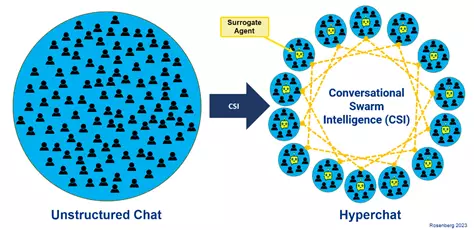In a world where businesses require swift and intelligent decision-making, gathering a large team to brainstorm can feel like herding cats. The conventional wisdom posits that the ideal context for productive dialogue is a compact group of 4 to 7 individuals. Beyond this size, conversations often devolve into chaos—where voices compete for attention, interruptions become the norm, and essential insights get lost in the din. This complex dynamic raises an essential question: can technology intervene to muster collective intelligence from larger groups? Enter hyperchat, a groundbreaking advancement that promises not only to facilitate real-time discussions among dozens—or even hundreds—of individuals but also to amplify the collective intelligence of those participants.
What Is Hyperchat?
Hyperchat, or conversational swarm intelligence, leverages artificial intelligence to transform how large teams converse and innovate. Unlike traditional platforms where discussions can spiral out of control, hyperchat intelligently segments larger groups into manageable subgroups, each equipped with a unique AI agent known as a “conversational surrogate.” These surrogates extract contextual insights from their particular subgroup and facilitate the sharing of knowledge with other groups synchronously. Thus, it creates a robust framework for collaborative brainstorming where diverse perspectives can be shared and integrated efficiently.
Notably, this concept was recently tested in a fascinating experiment orchestrated by Unanimous AI, which brought together 50 random sports fans to collaboratively create a March Madness bracket. This real-time deliberation would typically be stymied by logistical issues, but hyperchat efficiently streamlined the collaboration process, showcasing its potential to redefine how teams approach complex tasks.
The Experiment: Results Beyond Expectations
To gauge the effectiveness of hyperchat, the 50 sports fans created their March Madness bracket while employing the innovative Thinkscape platform. The results were astonishing. The bracket achieved an impressive ranking in the 99th percentile of the ESPN contest, indicating that the collective decision-making of these casual fans surpassed that of millions of other competitors. What makes this achievement even more remarkable is the fact that the bracket was created in real-time, underscoring the untapped capabilities of collective intelligence when enhanced by technology.
This performance extends beyond sports to broader implications for business settings and decision-making across industries. If the march of 50 individuals can yield such extraordinary outcomes in a specific context, one must consider the transformative potential of hyperchat in more critical and complex domains, such as strategic planning or crisis management.
Amplifying Intelligence: The Science Behind It
Diving deeper into the scientific undercurrents, a study conducted by Carnegie Mellon and Unanimous AI revealed staggering results: when random groups of individuals engaged in hyperchat, their collective IQ surged from the average of 100 to an effective IQ of 128—placing them in the upper echelon of intelligence. This remarkable boost argues compellingly for the implementation of such technology to improve outcomes across various sectors.
Moreover, research also illustrates that individuals engaged in real-time hyperchat not only reported feeling more productive but also fostered a greater sense of ownership and buy-in regarding the solutions produced. This psychological engagement can catalyze innovation and commitment that traditional brainstorming fails to achieve, further solidifying hyperchat as a game-changer in collaborative processes.
The Future: Human-AI Collaboration
But perhaps the most exhilarating potential lies in the hybridization of human and AI capabilities that hyperchat fosters. By integrating a second type of AI known as a “contributor agent,” which supplies real-time factual content to support ongoing discussions, hyperchat seeks to cultivate a “hybrid collective superintelligence.” This aspiration is not only a technological advancement but a philosophical shift toward democratizing decision-making processes, enabling extensive participation while ensuring that human intuition and creativity remain central to the conversation.
In a notable test involving fantasy baseball teams, groups that collaborated through hyperchat reported enhanced decision-making efficacy, with an impressive 87% of participants attesting to better outcomes stemming from this structure. Such results reinforce the notion that when human ingenuity and artificial intelligence join forces, the possibilities are limitless.
A Paradigm Shift in Team Collaboration
Hyperchat signifies a radical departure from conventional group interactions, serving as a beacon of hope for organizations striving for agile and effective decision-making in today’s fast-paced environment. With an ever-growing number of employees and teams in Fortune 1000 companies, traditional brainstorming approaches have become bottlenecks rather than bridges. Hyperchat not only dismantles these limitations but paves the way for a future where collective genius is harnessed at scale, ensuring that innovation and collaboration remain at the forefront of strategic endeavors.
As we witness the evolution of team dynamics, the results from initiatives like March Madness suggest that this innovative technology could herald a new era of collaboration that is effective, inclusive, and inspired. Who knows what incredible ideas could emerge when empowered individuals speak—no longer as solitary voices, but as a symphony of collective thought?


Leave a Reply
You must be logged in to post a comment.